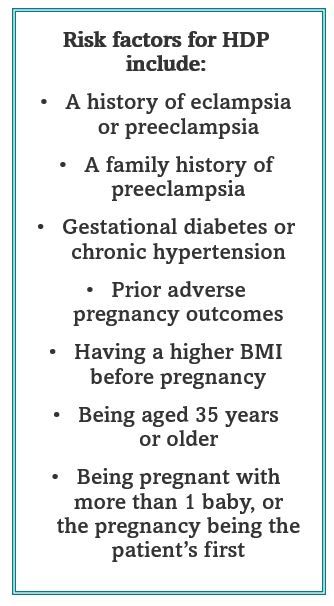- Clinical Technology
- Adult Immunization
- Hepatology
- Pediatric Immunization
- Screening
- Psychiatry
- Allergy
- Women's Health
- Cardiology
- Pediatrics
- Dermatology
- Endocrinology
- Pain Management
- Gastroenterology
- Infectious Disease
- Obesity Medicine
- Rheumatology
- Nephrology
- Neurology
- Pulmonology
USPSTF Publishes Final Guidance on Screening for Hypertensive Disorders of Pregnancy
The US Preventive Services Task Force on Tuesday issued a final recommendation statement on screening for hypertensive disorders of pregnancy (HDP) that indicates all pregnant individuals should have blood pressure (BP) measurements taken at each prenatal visit to help identify and prevent serious complications of gestational hypertensive disorders.1

The B-grade recommendation, published in full in JAMA,1 applies to all pregnant people without a diagnosis of a hypertensive disorder of pregnancy or without chronic hypertension. The final recommendation closely follows the task force’s draft recommendation from February and expands on its call in 2017 for routine BP screenings for preeclampsia during pregnancy.1
“The Task Force continues to find that measuring blood pressure at each prenatal visit is an effective way to screen for hypertensive disorders of pregnancy,” USPSTF member Esa Davis, MD, MPH, said in a press release. “Because these conditions can cause serious health issues, screening is an important way to keep pregnant people and their babies healthy.”2
According to data from the Centers for Disease Control and Prevention, prevalence of hypertensive disorders in pregnancy (HDP) among delivery hospitalizations rose from 13.3% to 15.9% from 2017 to 2019, and the prevalence was highest among women aged older than 45 years (31%), Black women (20.9%) and Native American or Alaska Native women (16.4%).3 Moreover, the risk of death from eclampsia or preeclampsia is approximately 5 times greater among Black women than among White women.1
The USPSTF recommendation is supported by a systematic literature review of the effectiveness of screening for HDP with the search conducted for relevant studies published between January 1, 2014, and January 4, 2022; with surveillance through February 21, 2023.1

The task force researchers, led by Jillian T. Henderson, PhD, MPH, an academic researcher at Kaiser Permanente, reviewed 6 “fair-quality” studies (5 randomized controlled clinical trials, 1 nonrandomized study) that compared changes in prenatal screening practices vs usual care, ie, routine screenings at in-office visits.1
Alternative practices included home BP monitoring, reduced numbers of prenatal visits for low-risk patients, and as-needed screening for proteinuria.
Henderson and colleagues found no evidence of significant differences in maternal and infant complications with alternate strategies compared with usual care.1 They did note that estimates for serious, rare health outcomes were imprecise. Specifically, their review found that home BP measurement was not associated with earlier diagnosis of HDP when added to prenatal care visits and there were no differences between groups in 3 trials of reduced prenatal visit schedules. The team reported no harms associated with the different screening strategies.1
USPSTF Vice Chair Wanda Nicholson, MD, MPH, MBA, said measuring BP in all pregnant persons is “an important first step,” but it is not enough to improve inequities faced by Black, Native American and Alaskan Native women.2
“We are using this recommendation to call for more research in this important area and to highlight promising ways to address these inequities and improve the health of those at increased risk,” Nicholson said in the release.2
In an accompanying editorial,4 Anna E Denoble, MD, MSc, and Christian M Pettker, MD, both of the Department of Obstetrics, Gynecology and Reproductive Sciences at Yale School of Medicine, noted that the United States is “mired in a maternal health crisis,” and that HDP are no exception to the underlying “marked racial, ethnic, and socioeconomic disparities…”4
The editorialists also commented on the dearth of studies to support the USPSTF’s recommendations. They note, for example, that the evidence still only supports routine BP measurements at in-person prenatal visits, suggesting limited research into alternative screening measures. The current practice was established nearly a century ago, they pointed out.4
The larger maternal health crisis, emphasize Denoble and Pettker, requires a more focused and multilevel effort, with collaboration among “national and local governments, communities, health care systems, and individuals and families” to reduce risk factors…to conceive of innovative screening and treatment modalities, and to ensure recognition of warning signs and that the voices of pregnant and postpartum people are heard.”4
